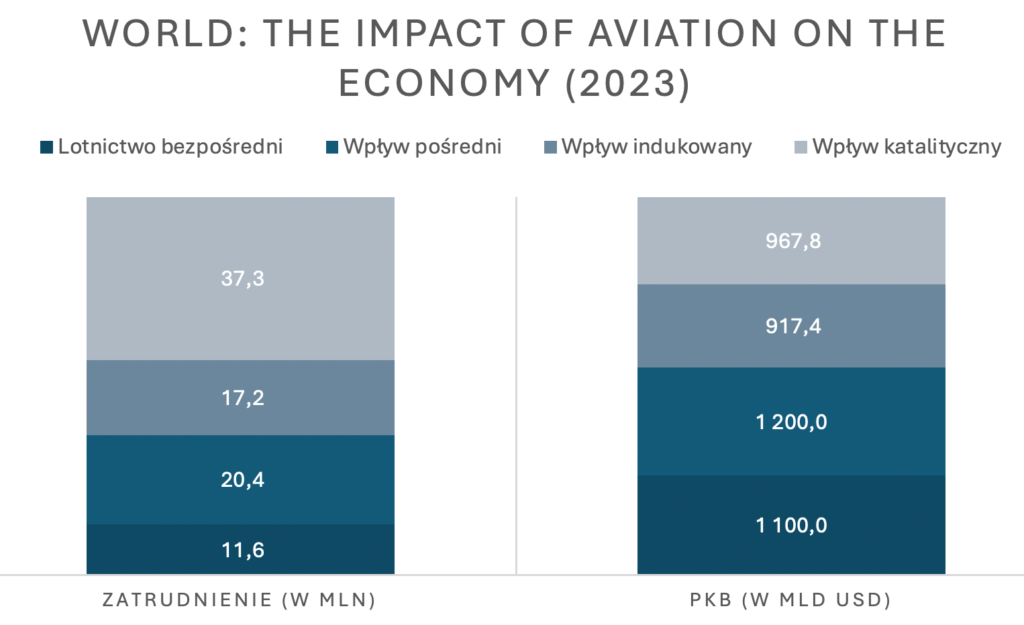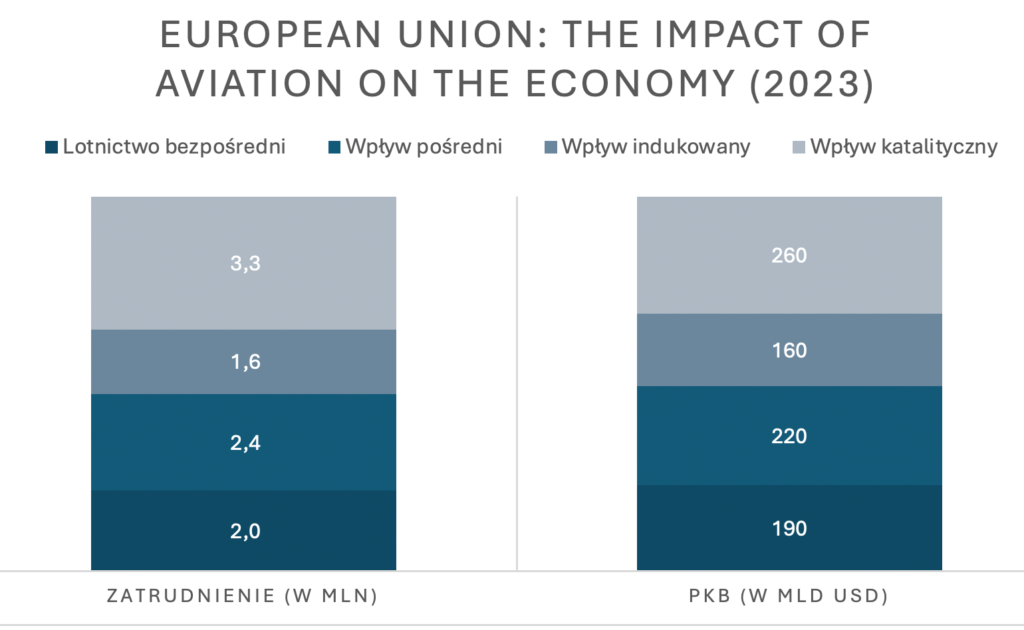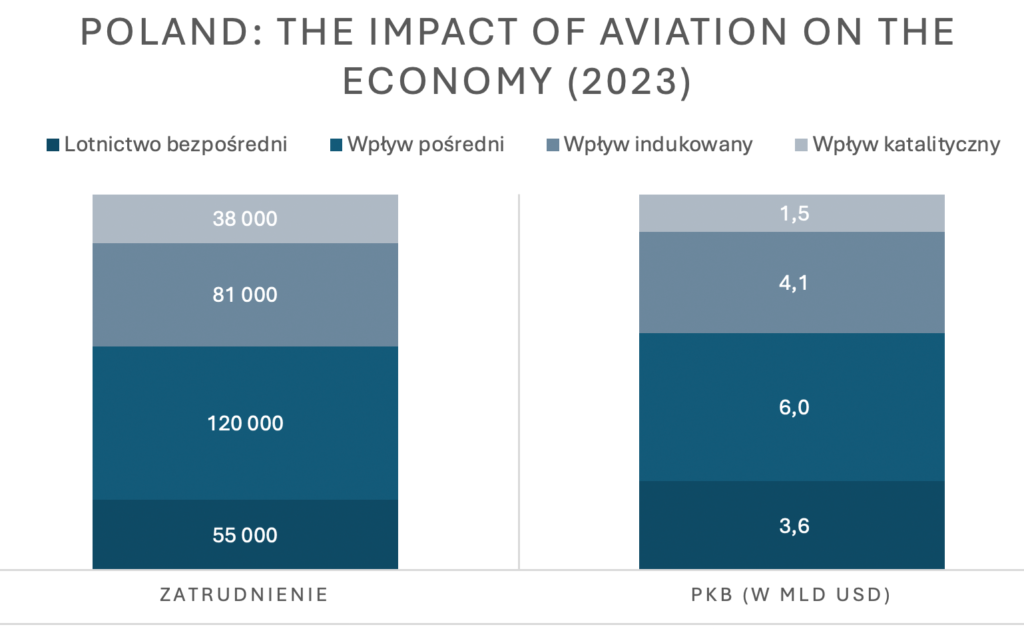
Aviation has a tremendous impact on the economy – a statement that every representative of the industry would wholeheartedly agree with. But what exactly does that mean? How big is this impact? How many jobs does the aviation industry create? What share of global GDP does it account for? There are some research studies that attempt to assess and estimate this impact.
Later last year, the Air Transport Action Group (ATAG), an association of 45 different aviation organisations, published its subsequent edition of the report “Aviation: Benefits Beyond Borders”[1]. The purpose of the report, which is based on analyses prepared by Oxford Economics, is to highlight the actual impact the aviation sector has both on a global and regional scale. To this end, data from most countries around the world are analysed. So let’s take a look at how Poland compares to the rest of the world and the European Union.
First, however, an important methodological note. The report is based on data from the previous year, which means that the latest edition from December 2024 is based on data from 2023. In an era of dynamic growth in some countries, this may seem like a distant prospect, however, it is important to remember that the report’s strength lies in its global scale and standardised approach to individual domestic markets[2].
How does aviation impact the economy?
Direct impacts, i.e. the aviation sector itself, include: airline passenger and cargo transport operations; airport operations, including security and safety providers; entities operating at airports, including handling, catering, MRO, stores, restaurants, hotels, car rental, offices and business areas. The direct impact also includes the services of air navigation service providers and the operation of companies involved in
the production of aircraft and their main components, such as engines and fuselages, as well as industry-specific engineering offices.
The authors of the report indicate that in 2023, 1,138 commercial airlines worldwide carried a total of 4.4 billion passengers to over 4,000 commercial airports around the world and transported 61.4 million tonnes of freight[1].
The industry directly provided 11.6 million jobs and contributed to the generation of USD 1.1 trillion, equivalent to 1 percent of global GDP[1]. The airports themselves employed 6.5 million people, 609,000 of whom were airport operators. Airlines provided 3.1 million jobs, while civil aerospace manufacturing employed 1.7 million people. Over 214,000 individuals provided efficient air navigation services[2].
Simply put, every million passengers served at an airport translates into approximately 1,000 jobs in the airport area[3].
Indirect impacts include operations of suppliers to the air transport industry within its supply chains. Here we can find, inter alia, suppliers of aviation fuel, radars and devices necessary for air navigation, food producers, construction companies, computer manufacturers, suppliers of goods to airport stores, and service providers for the aviation industry, including, for example, legal and accounting services, call centres and IT solution providers.
Just over 20.4 million indirect jobs globally were supported through the purchase of goods and services by companies in the air transport industry. As a result, this indirect impact of aviation contributed approximately USD 1.2 trillion to global GDP[1].
Induced impacts include the spending of those directly or indirectly employed in the air transport sector. Worldwide, 17.2 million induced jobs globally were supported through this spending. In 2023, the induced contribution to global economic activity was estimated at USD 917.4 billion[2].
Catalytic impacts include primarily spending by tourists travelling by air. Currently, this accounts for approximately 58 percent of all travellers. The direct contribution of air transport to employment in tourism is estimated at 16.4 million jobs, with a subsequent 21 million jobs resulting from the impact of aviation on the tourism industry[3].
When these factors are viewed together, air transport supported 37.3 million jobs within the tourism sector, supporting USD 967.8 billion a year to global GDP[4].
Of course, this is not a complete picture of the impact of aviation on our lives and economy. The report does not take into account other positive effects generated by aviation that are difficult to quantify, such as facilitating contacts and enabling transport. The figures do not therefore include issues such as: facilitation of international trade, increasing the availability of labour force, increasing productivity, improving access to the labour market, healthcare or education, maintaining family ties, etc.
European Union
Across the European Union, air transport contributed to 9.3 million jobs and generated USD 830 billion (EUR 760.3 billion) in GDP. This translates into 4.4 percent of total employment and 4.5 percent of total EU GDP in 2023. Over the next two decades, the aviation sector’s direct contribution to the EU’s GDP is forecast to grow by an estimated 2.4 percent annually, and employment by 1.1 percent per year.
Oxford Economics forecasts that by 2043, the impact of air transport and the tourism it facilitates in the European Union will have grown to support 14 million jobs (48 percent more than in 2023) and a USD 1.5 trillion contribution to GDP (79 percent increase)[1].
Poland
The report “Aviation: Benefits Beyond Borders” also presents calculations for our country. According to Oxford Economics, total employment in the aviation sector and the sector’s contribution to other industries reached 290,000, of which 55,000 were directly employed in aviation.
The sector contributed USD 15 billion to Poland’s GDP, of which USD 3.6 billion was generated by the aviation industry alone (direct impacts)[1].
– Today, we are clearly ahead of pre-pandemic aviation indicators, which, looking at a few examples in our immediate geographical vicinity, cannot be taken for granted. Employment in the aviation industry and generated by the aviation industry in Poland, as well as the impact of this sector on the economy, will continue to grow because our GDP is growing, and interest in air transport is growing along with economic growth and the increasing wealth of Poles. The aviation industry values stability and is naturally concerned today, for example, about the effects of the trade war, especially given the highly unpredictable actions of the new administration in the United States. In Poland, forecasts predict steady growth in transport, although actual figures are already significantly higher than these forecasts. Therefore, the share of aviation in GDP will continue to grow.
The authors of the report point out that data for previous years, especially in terms of induced and catalytic effects, are not fully comparable, but two figures are worth noting.
Data for 2018 showed that 136,000 jobs were created and the total economic impact amounted to USD 4.3 billion. These figures clearly show how much progress the Polish aviation industry has made over the last five years.
For many years, low-cost carriers have had by far the largest share of the Polish sky. However, we should bear in mind that the upcoming expansion of the fleet, followed by an increase in the number of routes and the launch of new destinations, will significantly boost LOT’s impact on the development of the Polish economy and the tourism industry. More connections directly translates into increased Poland’s tourism potential. But for air transport, the tourism industry would not have been able to accommodate as much as 30 percent of its customers, because that is how many tourists arrive in Poland by plane.

Adrian Furgalski, prezes zarządu Zespoły Doradców Gospodarczych TOR
[1] Air Transport Action Group (ATAG): https://atag.org/about-atag/.
[2] Air Transport Action Group (ATAG): https://atag.org/about-atag/.
[3] Jak piszą sami autorzy opracowania: „W raporcie „Aviation: Benefits Beyond Borders” należy traktować jako obraz sektora lotniczego w 2023 roku, a nie jako wyraz trwającego trendu. Różnice w źródłach danych sprawiają, że raporty z poprzednich lat nie są bezpośrednio porównywalne. W najnowszym badaniu firma Oxford Economics wprowadziła udoskonalenia danych i metodologii, które zwiększają wiarygodność wyników. Obejmują one przede wszystkim: wprowadzenie nowych źródeł danych dotyczących udziału turystów przybywających drogą lotniczą, usprawnienie szacunków wydatków turystów podczas pobytu w kraju, zastosowanie ulepszonych prognoz przepływów podróżnych”.
[4] Aviation: Benefits Beyond Borders 2024, ATAG, str. 11.
[5] Ibidem, str. 10.
[6] Ibidem, str. 19.
[7] Ibidem, str. 19.
[8] Ibidem, str. 20.
[9] Ibidem, str. 20.
[10] Ibidem, str. 21.
[11] Ibidem, str. 21.
[12] Ibidem, str. 59.
[13] Ibidem, str. 79.



